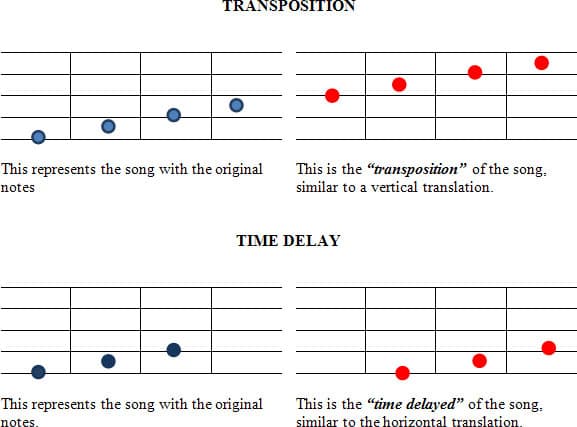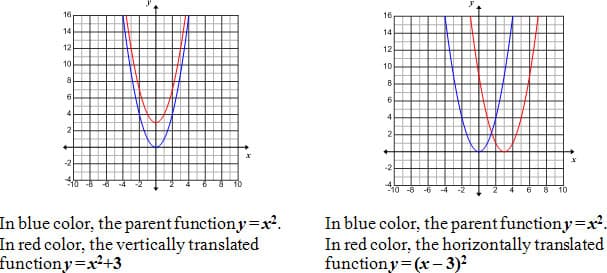A reflection in a pentagram
The idea of writing a melody of an original song is just to make it a challenge. However, students could choose any contemporary song as long as they are able to write and read the melody and its reflection in a pentagram. For the purpose of this unit, a reflection in a pentagram will be defined as the reflection of the notes over the third line, as mentioned on the previous paragraph.
The concept of translation can be as well introduced at this level to combine the idea of translating functions and "translating" melodies.
The process of translating melodies, notes, and in general, songs, is called in music "transposition." This musical concept of transposition is geometrically seen as a vertical translation. This means that if a song or melody is composed to be performed in the C note, but a new singer needs the same melody in the A note, the entire melody /song must be transposed to the respective note. However, the structure of the melody must be kept intact the same way as a function would be when it is being translated. Thanks to the frame (staff) used to write music, we can guarantee that this structure will be kept intact. For example if Frank Sinatra would sing a song and later on, Whitney Houston would want to sing the same song, it is obvious that the melody will be kept, but the keys (notes) will be adjusted to the proper voice. Key is the name given to the note or set of notes that would make up a melody or a song.
The translation of sounds in a period of time, also referred in music as "time delay," is another type of translation. In this case, the notes written on a pentagram are displaced horizontally to the right or to the left. This time delay is a horizontal translation.
With time delay, the melody / song will start before or after the original song. For a certain style, the song with original notes and the new one with the time delay may continue, creating a special effect as a duet.


The graph of y = x 2 + 3 is a vertical translation of y = x 2, three units up. The same way as a song / melody is being transposed from D to A. This process is continuously used in the music industry where composers create a song in a certain key, which later has to be adjusted to the voice of different singers. As a matter of fact, the same song may be recorded by different singers using the transpositions of the original song. Sometimes the transposition would go up, other times it would go down. The translation of the melody as well, may be used to create harmonic sounds applied continuously in duets, chorus and other performances. A harmonic sound is a combination of two sounds in different notes, one being a transposition of the other one.
The graph of y = (x – 3) 2 is a horizontal translation of y = x 2 three units to the right. It is important to mention the tendency to see y = (x – 3) 2 and think of a translation to the left. However, solving x – 3 = 0 will provide where the vertex is translating (moving) to.
There is a parallel concept between geometric translation in math and transposition in music. In both, there is a move from an original stage to a new one. While in math, the original and the new stages can be expressed as a set of points; in music the presence of a pentagram (staff) is needed. The pentagram plays the role of the Cartesian coordinate system. Depending on the action desired, the transposition is done moving all the notes up or down, while the time delay is done moving all the notes right or left.
In math, the coordinate system with its x–and y–axes is the structure to graph the functions (or relations). The pentagram (staff) provides the frame to write the music, which is translated into a geometric configuration. After having a geometric configuration, there can be geometric transformations. The question that arrives is if the transformations have any musical meaning. If so, what is that meaning?
The other part to explore in this curriculum unit at this point in relationship with music is the idea of reflecting the entire song with respect of the line that would be exactly in the middle of the entire song. This would imply to have the complete song written continuously on a single pentagram; look for the middle point and draw a vertical line to the pentagram, then, reflect the entire song over this vertical line. In reality this would mean to play the song in backwards.
There are different ways to perceive the geometric translations, reflections and rotations of the notes from the pentagram and therefore, get students interested in music and math.

Comments: